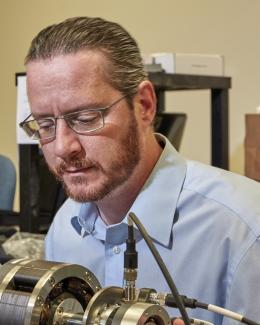ORNL researchers are demonstrating an automation system for this portable system, currently based in Colorado, for treatment of non-traditional water sources to drinking water standards. Credit: Tzahi Cath/Colorado School of Mines
Researchers at the Department of Energy’s Oak Ridge National Laboratory are developing advanced automation techniques for desalination and water treatment plants, enabling them to save energy while providing affordable drinking water to small, parched communities without high-quality water supplies.
Climate change and growing populations are straining the lakes, rivers and aquifers that traditionally provide clean water. Today, more towns need to be able to treat brackish, salty or biologically-polluted water to drinking water standards. But operating this more complex treatment often requires expensive technical expertise.
Through DOE’s National Alliance for Water Innovation research program, ORNL, universities and private companies are working together to develop and demonstrate fully-automated, multi-stage treatment systems that are effective at making nontraditional water sources clean and healthy for drinking or irrigation.
Co-founded by ORNL and the National Renewable Energy Laboratory, NAWI is a research initiative that also seeks to make this treatment affordable, decentralized and energy-efficient even for water sources that vary daily in content and quality.
“Fully treating and reusing water creates a circular water economy,” said ORNL lead researcher Kris Villez. “We want to make a nontraditional water source economically competitive against a traditional, mostly pure water source, something we call ‘pipe parity.’ These nontraditional sources vary a lot in quality and availability. This means that they can only achieve pipe parity through automated controls,” allowing cost-efficient water treatment even for historically underserved or rural communities without a large tax base.
A team led by Villez is developing software based on machine learning that can make decisions about the best actions to maintain a high quality of treatment in the most efficient way, saving energy, money and water. Choices can be influenced by daily weather, drought conditions, real-time energy and water prices, plant maintenance and changes in the composition of the untreated water.
Villez said this type of water treatment automation could eventually be vital not only for municipal water systems in thirsty areas like the Colorado River Basin but also in water-intensive industrial facilities, such as food and beverage processors or utilities with water-based cooling systems.
“The central concept of NAWI has always been to increase water availability,” said Yarom Polsky, a NAWI topic area lead for process innovation and intensification. “Advanced automation is a critical element.” It enables optimization of the performance of water treatment systems, with benefits such as cost reduction and efficient adaptation to changes in the composition of source water.
“Making advanced automation accessible to small water utilities and small stand-alone systems is essential for widespread adoption,” said Polsky, who is also director of ORNL’s Manufacturing Sciences Division. “Small and medium-size system providers typically have fewer resources for hiring technical experts to implement advanced controls.”
Villez’s team already demonstrated similar but smaller-scale automated controls on a single-unit treatment system established in Aurora, Colorado, by the Colorado School of Mines. The city of Aurora, Baylor University and several software vendors are also partners in the project, which uses reverse osmosis to remove salt from water.
Researchers are currently pursuing the next step, developing controls for plant-wide optimization. This will be tested for the first time on a treatment train of six units that can flexibly switch between various levels and types of water treatment. Doing so enables an automated choice between using all units to produce municipal drinking water or only using a few to supply irrigation, depending on markets, costs and other changing conditions.
“We want to deliberately introduce changes to see if our model is accurate, so we have the ability to respond to adversarial events, inadvertent errors or gradual changes in the bacterial treatment process that you might not notice if you don’t compare,” Villez said. “We’re balancing economic performance with resiliency.”
In a related NAWI project, ORNL researchers are also building a digital twin of a real-world desalination plant owned by Orange County, California. This digital twin is a dynamic model of the plant, which allows testing diverse designs and controls in a virtual laboratory without affecting customers. Ultimately, the digital twin will enable a real-time response to changes in electricity pricing, avoiding water production at times when energy is most expensive.
Polsky points out that water treatment is both an energy-intensive process and an energy necessity. Clean water heats and cools today’s power plants and industrial processes. “As we proceed through our energy transition, water treatment is also likely to be critical for energy applications of the future,” such as producing green hydrogen for industry, transportation or long-term energy storage, he said.
Other researchers who contributed to these water treatment automation projects include ORNL’s Alexander Melin and Sally Ghanem, along with former ORNL postdoctoral researcher Dhrubajit Chowdhury. Funding was provided by NAWI and the DOE’s Advanced Materials and Manufacturing Technologies Office.
UT-Battelle manages ORNL for the Department of Energy’s Office of Science, the single largest supporter of basic research in the physical sciences in the United States. The Office of Science is working to address some of the most pressing challenges of our time. For more information, please visit energy.gov/science.






